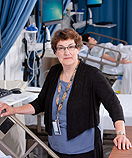News
Communication key to patient safety
-
 Print
Print -
 Comments
Comments
-

“Creating an environment where all members of the health care team…feel they can speak up about safety concerns that can prevent medical errors.”
Every time you are admitted to a hospital, you place your life in the hands of health care professionals. You trust them to provide the best treatment for you during your stay. You have no other choice.
However, it has been estimated by the Institute of Medicine (IOM) that anywhere from 44,000 to 98,000 individuals die in hospitals every year because of preventable medical error.
How can this be changed? The answer is: nurses. According to the IOM, nurses are the health care professionals most likely to intercept and prevent medical mistakes.
The issue has become so important that in 2008 the American Association of Colleges of Nursing identified patient safety and quality improvement as the second of nine essentials of baccalaureate education for professional nursing practice.
The UB School of Nursing is addressing the problem head on by offering an innovative and engaging patient-safety course as part of its undergraduate curriculum. The course begins with a lecture from a daughter who lost her mother to medical error, proceeds to research for how things go wrong and ends with a simulation of how events leading to the error could have been prevented.
Sharon Hewner, assistant professor of nursing and patient safety advocate, worked with a curriculum committee to develop the course, “Promoting Quality Health Outcomes and Culture of Safety,” that specifically addresses the ways nurses can raise their patient-safety awareness.
Hewner knows that one of the first things beginning nurses can do to prevent medical errors and improve patient safety is communicate.
“Communication is critical and structured communication techniques can prevent misunderstandings,” Hewner says. “Creating an environment where all members of the health care team, including doctors, nurses and pharmacists, feel they can speak up about safety concerns that can prevent medical errors.”
Hewner designed the course to begin with a human touch: She invited Mary Brennan-Taylor, a Western New York patient-safety advocate and a colleague on the Niagara Hospice Board on which they both served, to speak to the class about how her mother died of preventable medical error.
“After Mary spoke to our class about her mother’s experience in her last six weeks of life, the students asked how her death could have been prevented. It was an important question,” says Hewner.
From that initial question, Hewner set up teams of students who researched this case study as to what went wrong, what were the best evidence-based practice guidelines and how did medications contribute to the problem. Teams communicated in weekly blogs and then each team was assigned an episode in the patient’s last six weeks.
The teams then came to the clinical laboratory and acted out how the episode might have had a different outcome if there had been a culture of safety. Nursing faculty and Brennan-Taylor served as coaches to guide the students and give them a simulated experience of how to communicate more effectively to ensure patient safety. Finally, the students summarized what they learned through the simulation experience and created posters to illustrate what they had learned.
Brennan-Taylor was impressed by what she observed during the presentations and simulations. “This is an extremely effective way to teach patient safety—and, it’s innovative. I don’t think anyone is putting it together for students in the way that UB’s School of Nursing is,” she notes
What are UB’s plans to get the word out about teaching patient safety in this way for students and practicing nurses at other institutions? “Right now the plan is to publish about the event as an innovative approach to nursing education and as a way to engage students in schools of nursing in patient safety issues,” Hewner says. “The director of the nationwide Safe-Patient Project thinks this is something that should be emulated and rolled out across the U.S.”

Reader Comments